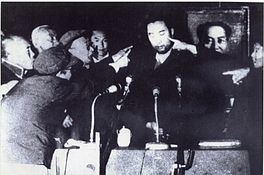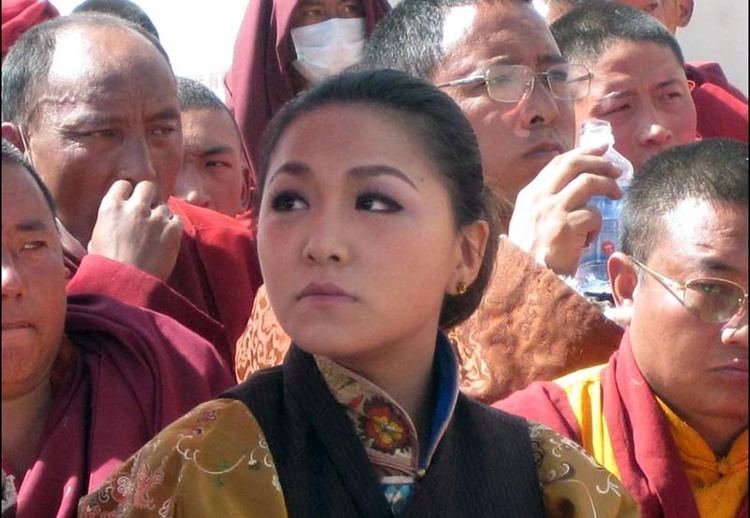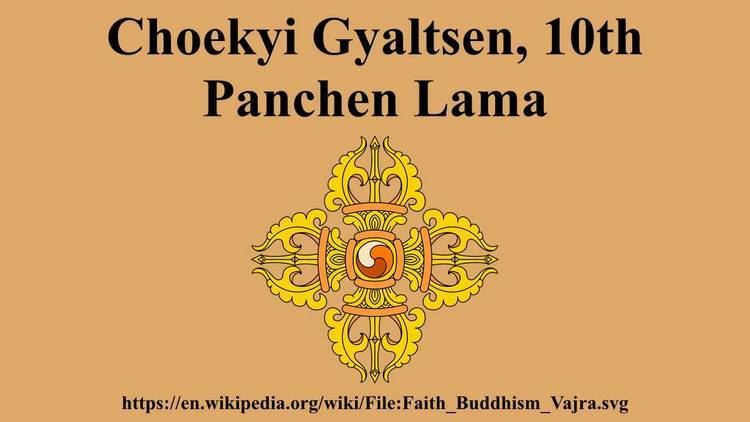Coronation 11 June 1949 Children Yabshi Pan Rinzinwangmo Name Choekyi 10th | Tibetan བློ་བཟང་ཕྲིན Spouse Li Jie | |
 | ||
Reign 3 June 1949 – 28 January 1989 Issue Yabshi Pan Rinzinwangmo Similar People Gyaincain Norbu, Gedhun Choekyi Nyima, Yabshi Pan Rinzinwangmo, 5th Dalai Lama, Je Tsongkhapa | ||
Choekyi Gyaltsen, 10th Panchen Lama
Lobsang Trinley Lhündrub Chökyi Gyaltsen (19 February 1938 – 28 January 1989) was the tenth Panchen Lama of the Gelug School of Tibetan Buddhism. He was often referred to simply as Choekyi Gyaltsen (which can be Choekyi Gyaltse, Choskyi Gyantsen, etc.), although this is also the name of several other notable figures in Tibetan history.
Contents
- Choekyi Gyaltsen 10th Panchen Lama
- Early life and selection
- Early politics
- 70000 Character Petition
- Opposition and humiliation
- Later life and death
- Daughter
- Return to Tibet and death
- References

Early life and selection

The 10th Panchen Lama was born Gonpo Tseten on 19 February 1938 in today's Xunhua Salar Autonomous County of Qinghai, to Gonpo Tseten and Sonam Drolma. When the Ninth Panchen Lama died in 1937, two simultaneous searches for the tenth Panchen Lama produced two competing candidates, with the government in Lhasa (who had selected a boy from Xikang) and the Ninth Panchen Lama's officials (who picked Tseten) in conflict. The Republic of China government, then embroiled in the Chinese Civil War, declared its support for Tseten on 3 June 1949. Guan Jiyu, the head of the Mongolian and Tibetan Affairs Commission, joined Kuomintang Governor of Qinghai Ma Bufang in presiding over Tseten's enthronement on 11 June as Choekyi Gyaltsen at Kumbum Monastery. The Dalai Lama's government in Lhasa still refused to recognize Gyaltsen.

The Kuomintang wanted to use Gyaltsen to create a broad anti-Communist base in Southwest China. The Kuomintang formulated a plan where 3 Khampa divisions would be assisted by the Panchen Lama to oppose the Communists.

When Lhasa denied Gyaltsen the territory the Panchen Lama traditionally controlled, he asked Ma Bufang to help him lead an army against Tibet in September 1949. Ma tried to persuade the Panchen Lama to come with the Kuomintang government to Taiwan when the Communist victory approached, but the Panchen Lama declared his support for the Communist People's Republic of China instead. The Panchen Lama, unlike the Dalai Lama, sought to exert control in decision making. In addition, the Dalai Lama regime was tottering, and his government displayed negligence in affairs, the Kuomintang using this to their advantage to expand into the Lhasa regime of the Dalai Lama.
Early politics
The Panchen Lama supported China's claim of sovereignty over Tibet, and China's reform policies for Tibet. Radio Beijing broadcast the religious leader's call for Tibet to be "liberated" into Tibet, which created pressure on the Lhasa government to negotiate with the People's Republic. In 1951, the Panchen Lama was invited to Beijing as the Tibetan delegation was signing the 17-Point Agreement and telegramming the Dalai Lama to implement the Agreement. He was recognized by the 14th Dalai Lama when they met in 1952.
In September 1954, the Dalai Lama and the Panchen Lama went to Beijing to attend the first session of the first National People's Congress, meeting Mao Zedong and other leaders. The Panchen Lama was soon elected a member of the Standing Committee of the National People's Congress and in December 1954 he became the deputy chairman of the Chinese People's Political Consultative Conference. In 1956, the Panchen Lama went to India on a pilgrimage together with the Dalai Lama. When the Dalai Lama fled to India in 1959, the Panchen Lama publicly supported the Chinese government, and the Chinese brought him to Lhasa and made him chairman of the Preparatory Committee for the Tibet Autonomous Region.
70,000 Character Petition
After a tour through Tibet in 1962, the Panchen Lama wrote a document addressed to Prime Minister Zhou Enlai denouncing the abusive policies and actions of the People's Republic of China in Tibet. This became known as the 70,000 Character Petition. According to Isabel Hilton, it remains the "most detailed and informed attack on China's policies in Tibet that would ever be written."
The Panchen Lama met with Zhou Enlai to discuss the petition he had written. The initial reaction was positive, but in October 1962, the PRC authorities dealing with the population criticized the petition. Chairman Mao called the petition "... a poisoned arrow shot at the Party by reactionary feudal overlords."
For decades, the content of this report remained hidden from all but the very highest levels of the Chinese leadership, until one copy surfaced in 1996. In January 1998 upon the occasion of the 60th anniversary of the birth of the Tenth Panchen Lama, an English translation by Tibet expert Robert Barnett entitled A Poisoned Arrow: The Secret Report of the 10th Panchen Lama, was published.
Opposition and humiliation
In 1964, he was publicly humiliated at Politburo meetings, dismissed from all posts of authority, declared 'an enemy of the Tibetan people', had his dream journal confiscated and used against him, and then imprisoned. He was 26 years old at the time. The Panchen's situation worsened when the Cultural Revolution began. The Chinese dissident and former Red Guard Wei Jingsheng published in March 1979 a letter under his name but written by another anonymous author, denouncing the conditions at Qincheng Prison where the 10th Panchen Lama was imprisoned. In October 1977, he was released but held under house arrest in Beijing until 1982. After his release, he was considered by the PRC authorities to be politically rehabilitated and he then rose to important positions. He served as Vice Chairman of the National People's Congress.
Later life and death
In 1978, after giving up his vows of an ordained monk, he travelled around China, looking for a wife to start a family. He began courting Li Jie, a soldier and medical student at Fourth Military Medical University in Xi'an. At the time, the Lama had no money and was still blacklisted by the party, but the wife of Deng Xiaoping and widow of Zhou Enlai saw the symbolic value of a marriage between a Tibetan Lama and a Han woman. They personally intervened to wed the couple in a large ceremony at the Great Hall of the People in 1979. One year later, the Panchen Lama was given the Vice Chairmanship of the National People's Congress and other political posts, and he was fully politically rehabilitated by 1982.
Daughter
Li Jie bore a daughter in 1983, named Yabshi Pan Rinzinwangmo. Popularly known as the "Princess of Tibet", she is considered important in Tibetan Buddhism and Tibetan-Chinese politics, as she is the only known offspring in the over 620-year history of either the Panchen Lama or Dalai Lama reincarnation lineages. Rinzinwangmo was schooled in the United States for 10 years where her legal guardian was American actor Steven Seagal, prior to returning to China in 2005. That same year, Rinzinwangmo began her PhD in Finance at the Tsinghua University in Beijing. In June 2010, Rinzinwangmo finished her doctoral thesis and graduated. As both a Chinese/Tibetan and a global youth leader, Rinzinwangmo dedicates much of her time and energy to her ongoing roles with numerous global charities and organizations: namely the All-China Youth Federation, Tibet Red Cross, Snowland Great Rivers Environmental Protection Association, and several orphanages and eye camps in the Tibetan ethnic regions. Rinzinwangmo is fluent in several Tibetan dialects, Mandarin Chinese and English.
Li Jie's father is Dong Qiwu, a general in PLA who commanded an Army in the Korean War.
Return to Tibet and death
Early in 1989, the 10th Panchen Lama returned to Tibet to rebury some of the recovered bones from the graves of the previous Panchen Lamas, graves that had been destroyed during the destruction of Tashilhunpo in 1959. He died from a heart attack in Shigatse at the age of 51, on 28 January, just five days after delivering a speech in Tibet in which he said: "Since liberation, there has certainly been development, but the price paid for this development has been greater than the gains." Although the official cause of death was said to have been from a heart attack, some Tibetans suspect foul play. In 2011, the Chinese dissident Yuan Hongbing declared that Hu Jintao had masterminded the death of the 10th Panchen Lama. The 10th Panchen Lama's death sparked an unprecedented six-year dispute over his assets amounting to $20 million between his wife and daughter and Tashilhunpo Monastery. The Dalai Lama was invited by the Buddhist Association of China to attend the Panchen Lama's funeral and to take the opportunity to contact Tibet's religious communities. Because of the short notice, the Dalai Lama was unable to attend the invitation. and new disputes materialized between the Chinese government and supporters of the Dalai Lama.
Many legends and conspiracy theories spread among Tibetans about the Panchen Lama's death. According to one story, he foresaw his own death in a message to his wife on their last meeting. In another, a rainbow appeared in the sky before his death. Some people, including the Dalai Lama, believe that he was poisoned by his own medical staff. Supporters of this theory cite remarks the Panchen Lama made on 23 January to high-ranking officials and that were published in the People's Daily and the China Daily. The message criticized the excesses of the Cultural Revolution in Tibet and praised the reform and opening up of the 1980s. His daughter Rinzinwangmo refused to comment on the conspiracy theories, attributing his early death to his generally poor health, extreme weight gain, and chronic sleep deprivation.
